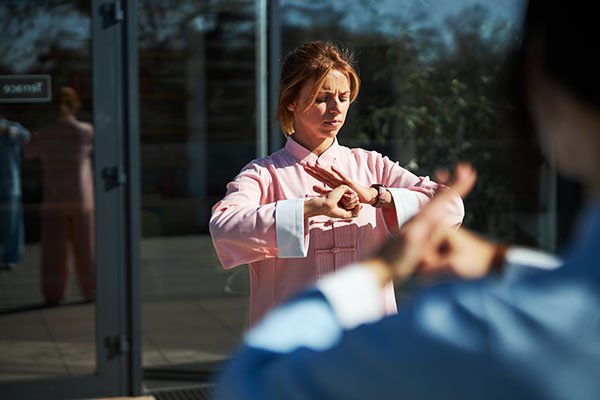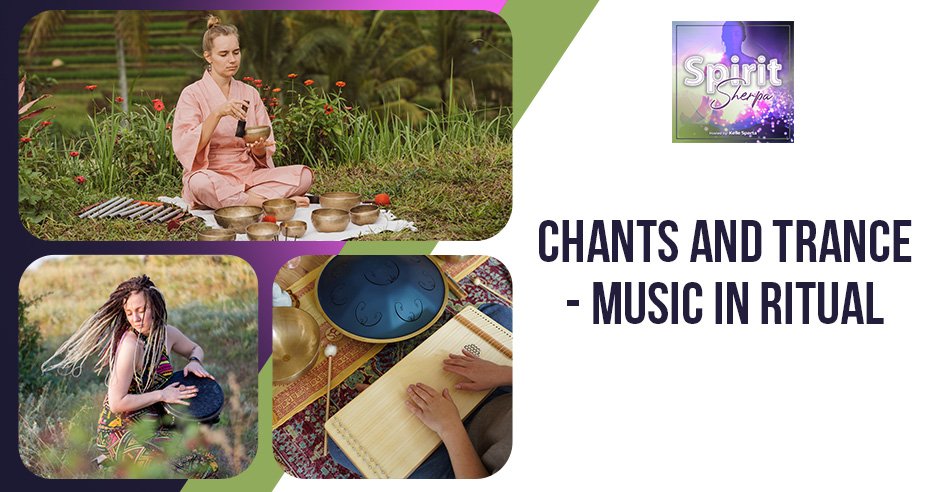In this episode, Kelle discusses Chants and Trance. Chants are simple songs designed to call in certain energies. When chants are used in a group, it aligns the energy of the group participants. A trance is stepping out of your normal conscious state when moving to music; it’s a loss of awareness of your surroundings and a complete focus on the movement of the body. Trancing is not meditation even though it can feel meditative. Instead, during meditation you are not aware of your body and completely in your head.
References:
-For more information about Kelle Sparta or Kelle Sparta Enterprises:
https://spiritualcoachcertification.us/learn-more-about-kelle/
-For more information about Kirtan: https://en.wikipedia.org/wiki/Kirtan
-For more information about Abigail Spinner McBride: https://www.facebook.com/people/Abigail-Spinner-McBride/100016167999361 or https://store.cdbaby.com/Artist/AbbiSpinnerMcBride
-For more information about Shawna Carol Goddess Chant: https://g.co/kgs/yHUJzF
-For more information about Earth Spirit Community: http://www.earthspirit.com/
-Driveabout (Full Version) https://youtu.be/biD21gy6qZk
–Written by: Kelle Sparta
–Performed by: Kelle Sparta and Daniel Singer
–Produced by: Daniel Singer
Keywords:
Kelle Sparta, The Spirit Doctor, Spirit Sherpa, Spirit, Spiritual Life, Manifestation, Magick, Realms, Shaman, Shamanism, Wicca, Paganism, Life Transformation, Personal Journey, Personal Growth, Chants, Chanting, Trance, Trancing
Credits and Licensing:
“Spirit Sherpa” is the sole property of Kelle Sparta Enterprises and is distributed under a Creative Commons: BY-NC-ND 4.0 license. For more information about this licensing, please go to www.creativecommons.org. Any requests for deviations to this licensing should be sent to kelle@spiritualcoachcertification.us. To sign up for, or get more information on the programs, offerings, and services referenced in this episode, please go to www.kellesparta.com. This episode of “Spirit Sherpa” has been produced by Honu Voice Productions.
—
Chants And Trance – Music In Ritual
With me, as always, is the Spirit Doctor, Kelle Sparta.
Joey.
We are going to get jiggy. We are going to be talking about chanting and trancing. We will get to trancing later. That, to me, is like dance music. In chanting, we are not talking about, “Hell no, we won’t go.” That’s not the type of chanting that has anything to do with spiritual journeys and the show. What the heck are we talking about?
We are usually talking about very simple musical songs that are designed to bring about specific energies. Chanting is used for a variety of different things in solo practice. It is used to bring certain energies into form. For instance, there’s a chant that’s simply like, “I open. I receive.” That’s the entirety of the chant. I spent 3 hours 1 day on a drive to Western Mass Upstate New York singing that. I arrived radiant and walked in. Everyone stopped and stared at me.
I chanted it because I was coming into a tantra retreat. I was half a day late. I was like, “I better get my energy into the right place so that I can mesh.” I overshot. If you do that chant alone for a long period, it will put you in a very different place energetically. There are chants that are gratitude-based. I’ve written a chant, “Brother tree, thank you for the shade. Sister breeze, thank you for the blowing. Father sky, thank you for the sun. Mother Earth, thank you for the knowing.”
It’s a very simple gratitude chant. If you are conscious of what you are singing as you are singing it, it will bring you gratitude. The chants are designed to bring you into a very specific energetic. In a group environment, chanting serves a different purpose. It can do the things that it does in a solo space but it is more often used as a way to bring different people’s energies together.
Unless you have people who are highly trained, getting a group of people, especially in this day and age where it’s ADD hell to focus in the same direction for any length of time, is next to impossible unless they are highly trained and disciplined in their practice. We use chanting. Chanting, especially if it’s a chant you don’t know, and you are trying to learn, focuses you on the intent of the words and the music. It brings your energy into alignment with the other people in the circle and allows you to connect your energy to them with a common intent.
Is it about the words? Are the words the vehicle to reach the focus? It’s not a magic spell.

It can be. It doesn’t have to be. Kirtan is very popular. Kirtan is chanting in Sanskrit. It’s the same thing. It’s just that you don’t know what the words mean a lot of the time, which I don’t particularly prefer because if I don’t know what it means, I don’t want to be chanting it with intention with a bunch of other people. It’s a safety thing for me but if I get a translation, understand what it means, and know that about it, then that’s fine. I don’t have anything against Kirtan in general. It’s just that I prefer to know what the words mean that I’m saying.
Remember, we talked about high magic and low magic in an earlier episode. Chanting in Sanskrit connects you to the high magic elements of that because you are chanting the same words that other people have chanted for generations. The people who started the chanting presumably knew what the words meant. Therefore, that energy has been carried forward all these years. You are tapping into that line of energy. It’s not more or less powerful. It’s differently powerful.
The power comes from a different place. You are connecting with each other but you are also connecting to the historical line of the chant. When you are doing chants that are in English or a modern language, presumably those chants have not been done for as long as the ones in ancient languages because of the length of time of language has been around. There are chants in the pagan community that has been done for decades by large numbers of people over time that you can tap into that same energetic.
There’s Isis Astarte. That chant has been around forever. There’s Earth My Body. That chant has been around forever. There are Native American chants out there that are much longer held but they are translated into English. Therefore, you are jumping the language difference but if you are holding the intention, then you are probably okay with tapping into that ancestral line.
The chants themselves have meaning. One of my favorite chant CDs is Shawna Carol’s, Goddess Chant. I adore it because it’s got some great chants turned into songs. It’s mostly a chant but it’s a little bit of a song. It bridges that gap between a simple chant and what we consider to be music. It’s got layers of different harmonies. I love to harmonize. It makes me happy. There’s that. That one is very specifically a goddess-based and divine feminine.
Do you need to be musical to chant?
Not really but you need to be able to hold a tune if you are going to do it in a group setting. As long as you have people on either side of you who can hold a tune, then they don’t care. As long as you are not throwing off the people on either side of you, you are okay, even if you can’t hold a tune. My grandfather was notorious for being tone-deaf. My mother used to describe it all the time. He would say, “I like this new song.” It goes, “Baby, I love you. Yes, I do. Can you love me back?” He would get the rhythm wrong and everything but he loved his music. You could do it. It could happen.
What about trancing? What is trancing?

Chants And Trance: Traditional meditation is mental and spiritual, while traditional stillness and trance practice are more of an embodied experience. Meditation is masculine, and trance is feminine.
Trancing is the act of stepping out of the level of normal consciousness and into a meditative state. Trance is meditation and movement. People don’t often talk about it as meditation because meditation has all these barriers to getting to it. It’s like, “I’ve got to stop thinking that I have to stop thinking.” It’s that whole thing. Trance, for some people, is more easily accessible because it’s a way to get out of your head and into your body. It depends on the type of meditation that you are doing. I tend to do a presence practice, which is about being fully present in the moment.
That is my meditation but it’s not technically meditation because it’s bringing yourself into the presence of everything in your environment. Presence and trance are much closer related than traditional meditation and trance because traditional meditation is more mental and spiritual. The traditional stillness and trance practice are more of an embodied experience. Meditation is masculine. Trance and stillness are more feminine. Trance is about letting go of your mind and allowing yourself to go with the flow of the music or the drums.
It is dance music. It’s not rave-type dance music.
It could be. People trance to rave music. If you turn it into a spiritual experience for yourself, you are trancing regardless but you can do a spiritual trance. You put your mind on the shelf. You are having the experience in your body. We see this most often in pagan circles drum circles where the dancers will come out and dance to the drums.
You have to watch people when they trance around a drum circle because usually, there’s a fire in the middle. When you are tranced, you may not be aware of the fire because you are so aware of your body. Trance is different than presence because, in the presence practice, you will be intensely aware of the fire but in a trance, you are inside your body. You are not in your environment.
You fully exist at the moment but not necessarily in your surroundings.
I’ve seen tranced people fall into fires. It’s not pretty.
Is the difference there between chanting and trancing the difference between the auditory aspect versus physical movement aspect of chanting versus trancing?

Typically, if you are singing, it engages too much of your brain to trance fully. I tranced when I did, “I open. I receive,” for three hours. After a while, you can put your brain on hold because you know what the words are, and your voice knows what notes are.
You were driving. It’s not a good time to be trancing.
I can bilocate like that. I’m good. I can have one part of my consciousness be fully aware of the environment around me, and the other part of me be tranced out and blissed out. It’s a skill I’ve built over time. I don’t recommend it. Don’t try this at home. I’m a professional driver on a closed course. If you can get to the point where it’s rote like that, it doesn’t normally come until you have been doing it for at least 40 minutes.
It’s getting yourself there.
It takes a lot to default it. I held space at a ritual once where I would have been able to transcend to it. It was a four-line chant. It was written in the same meter as, “I wish I may, I wish I might have the wish I wish tonight.” It was, “Black as day and dark of night, pull this something from my sight.” I don’t remember what the last few lines were because my brain kept fighting to keep, “I wish I may, I wish I might have this wish I wish tonight.”
It did not work if it had not been fighting for space that was already occupied by something else in my brain. We held that space for two hours. I would have tranced to that had I not been constantly fighting to keep it to be the right lyrics. It’s much harder to trance while chanting. That’s not the goal of chanting most of the time.
They are different there.
There’s music in ritual. When you have music and ritual, these are the two things that you generally run into. I felt like it was relevant to mention them both at the same time.

Chants And Trance: If you learn a chant from a CD or a recording online, be prepared because you might go to an event and find that they are doing it differently. You will often see the same chant in different iterations.
We talk about chanting. I’ve attended some of the sound healings that you do. Is that related at all? That’s sound but it’s not music necessarily.
It is sound but it’s not the same. Sound healing is using the vibrational energy of the sound to move energy in the body for healing purposes. It’s a very different animal.
Do you have anything you want to wrap up with? We are at a good point here with regards to tying out chanting and trancing for the folks at home.
If you are interested in chanting, what I would recommend is that you do some research online. Abigail Spinner is a very well-known writer of modern-day chants. She has some of the most beautiful chants I’ve ever heard. She’s got a bunch of CDs out. She’s a wonderful human. You should support her. I love Shawna Carol’s, Goddess Chant. If you do some searches, it’s a little harder to find these days.
There has been some stuff that has come up in the SEO for this. It used to be that you could do a pagan chant as a search, and it would show up with a whole bunch of archives from different organizations around the world. That’s not nearly as easy to do but if you do dig, you can find it. I know that Earth Spirit Community in Massachusetts has an archive of chants. You can find those there.
If you look, there are places to find them. The one fair warning is that chants have been handed down as an oral tradition. Therefore, if you learn it from a CD or a recording online, and then you go to an event, and they are doing it differently, be prepared because that’s often the case. There was one song that I wanted to do at an event. I went looking for a recording to put up for people to learn it in advance.
I could not find a single recording of it that was the way I had been taught it and had practiced it for years. There’s a huge community of people that I know who do it in that fashion. There was not a single recording. I had to make a recording for the people that I wanted because I was not going to relearn it in a new way for the event that I was running. Know that you will see the same chants in different iterations.
That is all that we have. We look forward to seeing you next time as Kelle adds yet another chapter to your beginner’s guide to energy magic and the spirit world.
Chant wide, chant loud, and chant long.
Important Links
- https://KelleSparta.com/learn-more-about-kelle/
- https://en.Wikipedia.org/wiki/Kirtan
- https://www.Facebook.com/people/Abigail-Spinner-McBride/100016167999361
- https://store.CDBaby.com/Artist/AbbiSpinnerMcBride
- https://G.co/kgs/yHUJzF
- http://www.EarthSpirit.com/
- https://YouTu.be/biD21gy6qZk
- www.CreativeCommons.org
- Kelle@KelleSparta.com
- www.KelleSparta.com
See acast.com/privacy for privacy and opt-out information.
